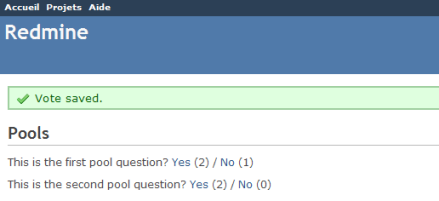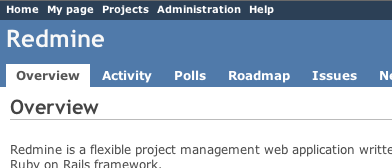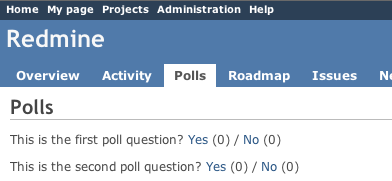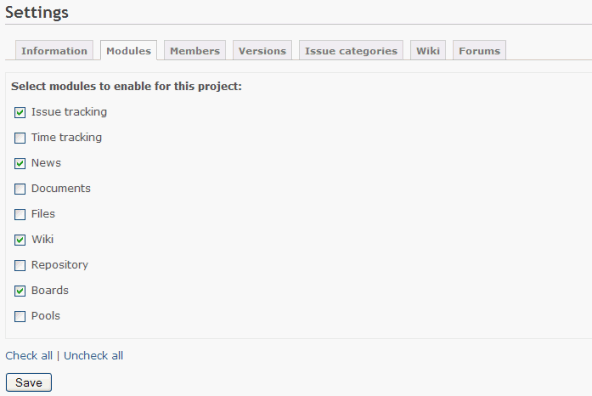Plugin Tutorial » History » Revision 12
« Previous |
Revision 12/119
(diff)
| Next »
Jean-Philippe Lang, 2008-08-10 19:42
Plugin Tutorial¶
- Table of contents
- Plugin Tutorial
Creating a new Plugin¶
Creating a new plugin can be done using the Redmine plugin generator.
Syntax for this generator is:
ruby script/generate redmine_plugin <plugin_name>So open up a command prompt and "cd" to your redmine directory, then execute the following command:
% ruby script/generate redmine_plugin PoolsThe plugin structure is created in vendor/plugins/redmine_pools:
create vendor/plugins/redmine_pools/app/controllers
create vendor/plugins/redmine_pools/app/helpers
create vendor/plugins/redmine_pools/app/models
create vendor/plugins/redmine_pools/app/views
create vendor/plugins/redmine_pools/db/migrate
create vendor/plugins/redmine_pools/lib/tasks
create vendor/plugins/redmine_pools/assets/images
create vendor/plugins/redmine_pools/assets/javascripts
create vendor/plugins/redmine_pools/assets/stylesheets
create vendor/plugins/redmine_pools/lang
create vendor/plugins/redmine_pools/README
create vendor/plugins/redmine_pools/init.rb
create vendor/plugins/redmine_pools/lang/en.yml
Edit vendor/plugins/redmine_pools/init.rb to adjust plugin information (name, author, description and version):
require 'redmine'
Redmine::Plugin.register :redmine_pools do
name 'Pools plugin'
author 'John Smith'
description 'A plugin for managing pools'
version '0.0.1'
end
Then restart the application and point your browser to http://localhost:3000/admin/info.
After logging in, you should see your new plugin in the plugins list:

Generating a controller¶
For now, the plugin doesn't do anything. So let's create a controller for our plugin.
We can use the plugin controller generator for that. Syntax is:
ruby script/generate redmine_plugin_controller <plugin_name> <controller_name> [<actions>]So go back to the command prompt and run:
% ruby script/generate redmine_plugin_controller Pools pools index vote
exists app/controllers/
exists app/helpers/
create app/views/pools
create test/functional/
create app/controllers/pools_controller.rb
create test/functional/pools_controller_test.rb
create app/helpers/pools_helper.rb
create app/views/pools/index.html.erb
create app/views/pools/vote.html.erb
A controller PoolsController with 2 actions (#index and #vote) is created.
Edit app/controllers/pools_controller.rb in redmine_pools directory to implement these 2 actions.
class PoolsController < ApplicationController
unloadable
@@pools = [ {:id => 1, :title => 'First pool', :question => 'This is the first pool question', :yes => 0, :no => 0},
{:id => 2, :title => 'Second pool', :question => 'This is the second pool question', :yes => 0, :no => 0} ]
def index
@pools = @@pools # Pool.find(:all)
end
def vote
pool = @@pools.find {|p| p[:id].to_s == params[:id]} # Pool.find(params[:id])
# saves the vote
pool[params[:answer].to_sym] += 1
flash[:notice] = 'Vote saved.'
redirect_to :action => 'index'
end
end
For the sake of this example, we simulate a pool model in our @@pools class variable.
We could of course use a ActiveRecord model just like we do it in a regular Rails app.
Then edit app/views/pools/index.html.erb that will display existing pools:
<h2>Pools</h2>
<% @pools.each do |pool| %>
<p>
<%= pool[:question] %>?
<%= link_to 'Yes', {:action => 'vote', :id => pool[:id], :answer => 'yes'}, :method => :post %> (<%= pool[:yes] %>) /
<%= link_to 'No', {:action => 'vote', :id => pool[:id], :answer => 'no'}, :method => :post %> (<%= pool[:no] %>)
</p>
<% end %>
You can remove vote.html.erb since no rendering is done by the corresponding action.
Now, restart the application and point your browser to http://localhost:3000/pools.
You should see the 2 pools and you should be able to vote for them:

Note that pool results are reset on each request if you don't run the application in production mode, since our pool "model" is stored in a class variable in this example.
Extending menus¶
Our controller works fine but users have to know the url to see the pools. Using the Redmine plugin API, you can extend standard menus.
So let's add a new item to the application menu.
Extending the application menu¶
Edit init.rb at the root of your plugin directory to add the following line at the end of the plugin registration block:
Redmine::Plugin.register :redmine_pools do
[...]
menu :application_menu, :pools, { :controller => 'pools', :action => 'index' }, :caption => 'Pools'
end
Syntax is:
menu(menu_name, item_name, url, options={})There are 4 menus that you can extend:
:top_menu- the top left menu:account_menu- the top right menu with sign in/sign out links:application_menu- the main menu displayed when the user is not inside a project:project_menu- the main menu displayed when the user is inside a project
Available options are:
:param- the parameter key that is used for the project id (default is:id):if- a Proc that is called before rendering the item, the item is displayed only if it returns true:caption- the menu caption that can be:- a localized string Symbol
- a String
- a Proc that can take the project as argument
:before,:after- specify where the menu item should be inserted (eg.:after => :activity):last- if set to true, the item will stay at the end of the menu (eg.:last => true):html_options- a hash of html options that are passed tolink_towhen rendering the menu item
In our example, we've added an item to the application menu which is emtpy by default.
Restart the application and go to http://localhost:3000:

Now you can access the pools by clicking the Pools tab from the welcome screen.
Extending the project menu¶
Now, let's consider that the pools are defined at project level (even if it's not the case in our example pool model). So we would like to add the Pools tab to the project menu instead.
Open init.rb and replace the line that was added just before with these 2 lines:
Redmine::Plugin.register :redmine_pools do
[...]
permission :pools, {:pools => [:index, :vote]}, :public => true
menu :project_menu, :pools, { :controller => 'pools', :action => 'index' }, :caption => 'Pools', :after => :activity, :param => :project_id
end
The second line adds our Pools tab to the project menu, just after the activity tab.
The first line is required and declares that our 2 actions from PoolsController are public. We'll come back later to explain this with more details.
Restart the application again and go to one of your projects:

If you click the Pools tab, you should notice that the project menu is no longer displayed.
To make the project menu visible, you have to initialize the controller's instance variable @project.
Edit your PoolsController to do so:
def index
@project = Project.find(params[:project_id])
@pools = @@pools # @project.pools
end
The project id is available in the :project_id param because of the :param => :project_id option in the menu item declaration above.
Now, you should see the project menu when viewing the pools:

Adding new permissions¶
For now, anyone can vote for pools. Let's make it more configurable by changing the permission declaration.
We're going to declare 2 project based permissions, one for viewing the pools and an other one for voting. These permissions are no longer public (:public => true option is removed).
Edit init.rb to replace the previous permission declaration with these 2 lines:
permission :view_pools, :pools => :index
permission :vote_pools, :pools => :vote
Restart the application and go to http://localhost:3000/roles/report:

You're now able to give these permissions to your existing roles.
Of course, some code needs to be added to the PoolsController so that actions are actually protected according to the permissions of the current user.
For this, we just need to append the :authorize filter and make sure that the Herve Harster instance variable is properly set before calling this filter.
Here is how it would look like for the #index action:
class PoolsController < ApplicationController
unloadable
before_filter :find_project, :authorize, :only => :index
[...]
def index
@pools = @@pools # @project.pools
end
[...]
private
def find_project
# @project variable must be set before calling the authorize filter
@project = Project.find(params[:project_id])
end
end
Retrieving the current project before the #vote action could be done using a similiar way.
After this, viewing and voting pools will be only available to admin users or users that have the appropriate role on the project.
Creating a project module¶
For now, the pool functionality is added to all your projects. But you way want to enable pools for some projects only.
So, let's create a 'Pools' project module. This is done by wraping the permissions declaration inside a call to #project_module.
Edit init.rb and change the permissions declaration:
project_module :pools do
permission :view_pools, :pools => :index
permission :vote_pools, :pools => :vote
end
Restart the application and go to one of your project settings.
Click on the Modules tab. You should see the Pools module at the end of the modules list (disabled by default):

You can now enable/disable pools at project level.
Improving the plugin views¶
TODO: adding stylesheet, setting page title
Updated by Jean-Philippe Lang over 17 years ago · 12 revisions